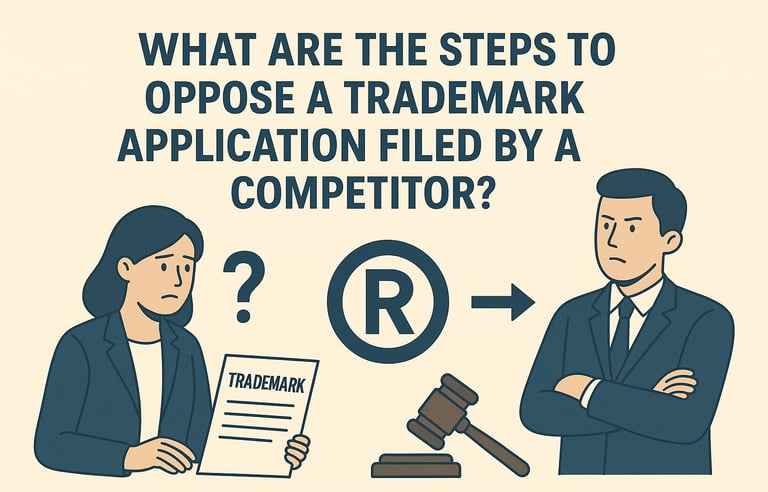What are the steps to oppose a trademark application filed by a competitor?What are the steps to oppose a trademark application filed by a competitor?
Trademark opposition is a way to stop other businesses from registering their name or logo which is similar to yours. This process includes steps like filing an opposition, presenting arguments and appearing before trademark registrar.
IPR
Sakshi Fouzdar
8/21/20253 min read


A trademark is very important as it shows the company’s brand value, reputation and identity in market. Sometimes other businesses try to register a trademark which is confusingly similar to yours or they may file it with malafide intention for unfair gain. To prevent this, the law provides a remedy known as Trademark Opposition, where you can challenge that application before it gets registered.
This is a legal process where one can object others trademark application before it gets registered to protect brand value of existing brand. In simple terms, it is a way for businesses to protect their intellectual property rights against a competitor’s trademark by filling a trademark opposition.
Grounds for Trademark Opposition
Before filing trademark opposition, it’s important to know the grounds on which you can challenge a trademark application. This includes:
· The new trademark is similar or identical to your trademark and could confuse customers.
· The trademark is common; it doesn’t differentiate the goods or services of one business from another.
· The application was filled with malafide intention to take unfair advantage.
· The trademark is inappropriate, prohibited by law or gives the wrong impression to the public.
Understanding these grounds gives you a stronger case when opposing a trademark.
Step 1: Tracking Trademark Applications
First step is to check regularly the trademark journal issued by Trademark Registry. And after the application is accepted by the examiner, it is published in journal for public review.
You should either monitor the journal personally or hire an IP Attorney to track any mark which may be confusingly similar to yours. This is important because opposition period is limited, and if you miss it, you can’t file.
Step 2: Filing a Notice of Opposition
If you identify a conflicting mark, you must file a Notice of Opposition within the prescribed time period of four months from the date the trademark is published in the Trademark Journal.
The notice of opposition has to be filed before Registrar of Trademarks in the prescribed format.
In the notice grounds of opposing the mark must clearly mention which includes similarity, pre-existing use, Lack of uniqueness, filled with malafide intention.
This is valid only when you pay the prescribed govt. fee at time of filling.
Step 3: Service of the Opposition Notice
After you file a Notice of Opposition, the Registrar will give a copy of it to your competitor. Then applicant gents a chance to defend their case by filing counter statement. And if applicant doesn’t file this in prescribed time then registration process automatically ends there.
Step 4: Filing of Counter-Statement by the Applicant
If the applicant wants to fight the opposition, they must file counter statement within prescribed period. This brings the matter under trial before the registrar.
If they fail to file counter statement in prescribed time then application is considered withdrawn, and they lose their right to defend.
Step 5: Submission of Evidence by Opponent
Once the applicant files counter statement you have to submit evidence to prove your case. This includes:
· Proof that you were using your trademark before the applicant.
· Proof that your brand has reputation in market.
· Document to show that applicant’s mark is confusingly similar to yours and may confuse the public.
These proves must be submitted in form of an affidavit, as per the law.
Step 6: Evidence Submission by Applicant
After you file your evidence, the applicant also gets a chance to defend their application. They can submit:
· Proof that they lawfully adopted the mark.
· Proof of their Bonafide intention to use the mark.
· Proof that the mark has already gained identity in the market.
This step ensures that both sides get chance to present their case before the registrar.
Step 7: Hearing Before the Registrar
Once both parties submitted their evidences, the Registrar fixes a hearing date.
During the hearing, the Registrar examines the evidences given by both parties, and grounds before deciding whether the applicant’s trademark should be registered or not.
Step 8: Decision by the Registrar
The Registrar gives a written order after examining all facts, evidences and arguments.
If the opposition succeeds, the applicant’s trademark will be refused.
If the opposition fails, the mark will move forward for registration.
After the order, either party has the right to appeal the decision before the Intellectual Property Appellate Board (IPAB) or the concerned High Court, depending on the jurisdiction.
Conclusion
Trademark opposition helps you to stop other party’s trademark application if it is similar to yours or can cause confusion among customers. It is filed before registration of trademark. If you act in prescribed time, you can file a notice of opposition and case will be decided after a hearing before the Registrar.
In short, opposition is not just about stopping a competitor, but it is a way to protect your brand name and safeguard your brand’s reputation in market.
